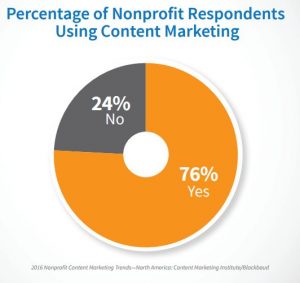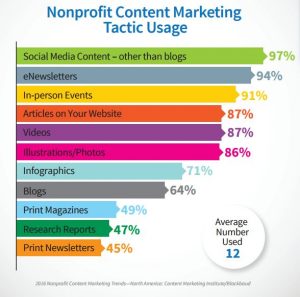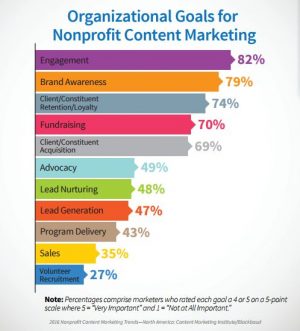
Whether your goal is to increase donations, find new volunteers, spread awareness or promote an upcoming campaign, your nonprofit website content is the place to start.
Your online content can do more than tell your story and educate visitors about your organization’s impact. Additionally, content can drive your Google rank up, and promote conversions into donors or volunteers.
In this post, we’ll offer seven stats that highlight the importance of content for nonprofit marketing — including which kinds of content are effective, and how to measure content metrics.
76% of nonprofit organizations employ content marketing tactics.

Nonprofits are notoriously resourced strapped, with a lack of people, time, and money. For them, content marketing serves as one of the most economical ways to increase awareness, find new leads, and convert more prospects.
Why? Because content marketing is evergreen and brings compounding returns over time, especially as your content starts ranking in search engines.
87% of nonprofit content marketers post articles to their website, while 64% of nonprofit content marketers publish blogs regularly.
 While posting any type of quality content to your website is great, blogging regularly is an ideal strategy. Unlike promotional articles about your organization, blog posts can draw in a new audience that is searching for topics related to your cause. For example, you can talk more broadly about trends, news, and events within your sphere — not just your nonprofit.
While posting any type of quality content to your website is great, blogging regularly is an ideal strategy. Unlike promotional articles about your organization, blog posts can draw in a new audience that is searching for topics related to your cause. For example, you can talk more broadly about trends, news, and events within your sphere — not just your nonprofit.
This kind of content, in addition to articles about the organization, will demonstrate how volunteer hours and donations impact your organization. And by regularly publishing around key topics, you will climb in search engines. Then, you can gradually build a strategy to increase web traffic and convert visitors into donors, subscribers, etc.
Therefore, posting articles in addition to blogging regularly is a great way for nonprofit marketers to educate audiences on your cause, your organization’s mission, and how to get involved.
45% of the most effective nonprofit content marketers offer blog subscriptions vs. 27% of the least effective.
Subscriptions are key for promoting your content to various audiences — first-time donors, repeat- or high-level donors, volunteers, advocates, etc. A newsletter subscription allows you to push content out to an audience without depending on them to return voluntarily to your site again and again. Even better, you can create custom newsletters for distinct reader groups.
This exact statistic separates out "blogs" from "e-newsletters," but we suggest you incorporate your top-performing blog posts into your newsletter sends.
47% of nonprofit content marketers say lead generation is an important goal.
Top nonprofit goals include engagement, awareness, and fundraising. However, lead generation (i.e., donor conversion or active volunteer conversion) is a goal that more nonprofit marketers should make a top priority. Remember, your website isn't just a static brochure — it's a fundraising website.

72% of nonprofit content marketers cite website traffic as one of the most important metrics used.
Many conversions begin with a simple web search, ending in a prospect looking for information. But traffic in itself isn't a strong goal for your organization. Only consider traffic a success so far as you're converting that traffic into subscribers, donors, volunteers, and advocates.
65% of nonprofit content marketers cite data capture as one of the most important metrics used.
Data capture is important because once you have a lead’s contact information, you can better target them for a reconversion — such as a follow-up donation or an advocacy action. Highly-targeted information is only possible if you capture the right details in subsequent forms.
Regular, helpful content has quickly become one of the most important weapons in the nonprofit marketer’s arsenal. It provides a way to connect to your organization on an emotional level. This helps to drive donor engagement and ongoing support.
Content is one of the best and most cost-effective ways to forge this connection with your audience, which drives them to offer help and continue providing financial support and time over the long haul.
https://contentmarketinginstitute.com/wp-content/uploads/2015/11/2016_NonProfit_Research_FINAL.pdf
by Jonathan Franchell, CEO of Ironpaper - For more tips and hacks: Need to remove a new line after h1 tags? Both web designers and SEO practitioners need to employ headline tags: H1, H2, H3 in several ways to improve web page structure and tag...

The marketing industry is transforming significantly due to generative AI and increasing market complexity. Gartner's prediction of a 25% decline in traditional search traffic suggests that the era of search engines is dying. AI tools, particularly...

The Crowded Arena of the IT Marketplace Updated December 2024 The Information Technology (IT) landscape is experiencing rapid growth and intensifying competition. IT spending is projected to reach nearly 5.1 trillion U.S. dollars in 2024, a...

Updated December, 2024 The field of digital marketing is evolving rapidly in response to new technology and changing buyer expectations. To help career-minded marketers, we’ve rounded up the top 10 skills needed to succeed in the field. These are...
